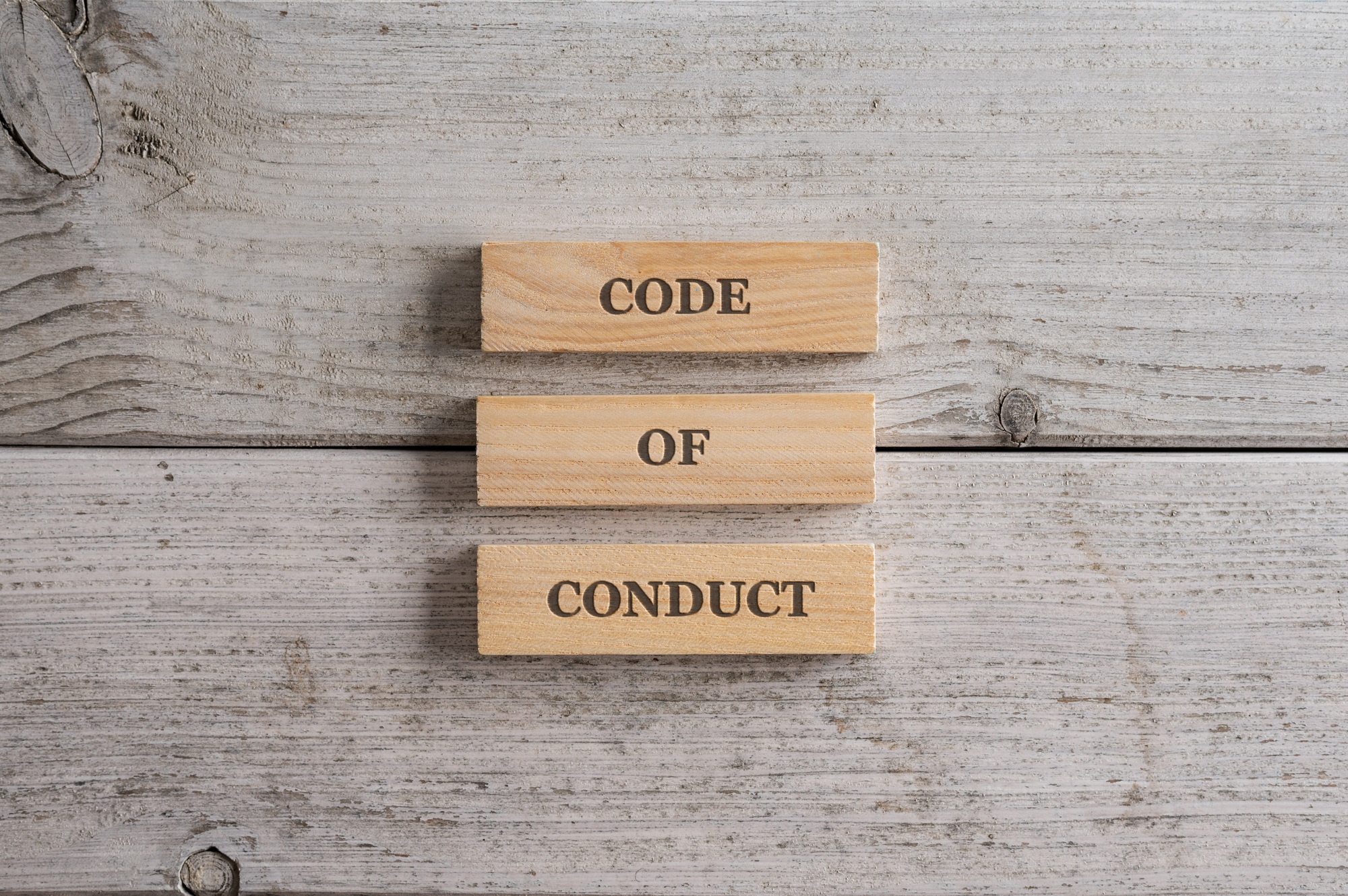A company’s code of conduct defines acceptable behavior and ethical standards in an organization. This guide explores its importance, essential elements, and steps for creating an effective Code of Conduct. Here are the 7 essential guidelines:
- Define the Purpose and Scope: Clearly outline the purpose of the code and the behaviors it covers, ensuring alignment with the company’s values and mission.
- Clarity and Accessibility: Ensure the code is written in simple language and easily accessible to all employees, promoting understanding and compliance.
- Applicability to All Employees: State that the code applies to everyone, from entry-level staff to executives, to foster fairness and accountability.
- Inclusion of Practical Examples: Incorporate real-life conduct examples to illustrate key points and clarify behavior expectations.
- Regular Review and Updates: Periodically review and update the code to address new ethical challenges and maintain relevance.
- Comprehensive Guidelines: Cover all important details, including expected behaviors and consequences, to prevent misunderstandings.
- Effective Communication and Training: Implement ongoing communication and training to reinforce the code’s principles and support ethical behavior

Key Takeaways
- A code of conduct is essential for establishing ethical business practices, promoting a positive workplace culture, and ensuring compliance with legal standards.
- Key elements of an effective code include clarity, accessibility, applicability to all employees, and comprehensive guidelines that outline expected behaviors and consequences in alignment with the company’s values.
- Regular review and updating of the code are vital to address evolving ethical challenges and maintain alignment with the organization’s values and industry standards.
Understanding the Importance of a Code of Conduct

A code of conduct is more than just a set of rules; it is the bedrock of ethical business practices. It promotes expected and unacceptable behaviors, helping to establish high standards of behavior within the organization. This foundational document is crucial for ensuring adherence to standards of integrity, fostering a positive culture, and preventing unethical behavior. A company’s code of conduct serves as a guiding framework for employees, outlining specific rules and procedures to ensure ethical behavior. Clearly defined company values and expectations guide employees through complex ethical decisions in their daily activities.
Moreover, a well-structured code of conduct significantly enhances the workplace culture. It promotes respect, accountability, and fairness, thereby creating an environment where employees feel valued and understood. The code serves both as internal guidelines for professional conduct and as an external representation of the organization’s values and commitments. This dual role is vital in linking the company’s mission with its professional behavior standards, ensuring that every action taken by the employees aligns with the organization’s ethical principles. Ultimately, this conduct ensures that the workplace remains a positive and productive space.
In addition to fostering a positive internal culture, compliance with laws like Sarbanes-Oxley mandates that organizations adopt a company code of conduct or justify its absence. This legal requirement underscores the importance of having a well-defined code, not just as a voluntary guideline but as a critical component of regulatory compliance.
In essence, a robust code of conduct is indispensable for any serious person or organization aiming to uphold high ethical standards and build a trustworthy reputation.
What is a Code of Conduct?
A company’s code of conduct is a set of rules and guidelines that outline the expected behavior of employees within an organization. It serves as a guide for employees to make ethical decisions and ensures that the organization operates in a responsible and compliant manner. This foundational document is essential for any organization as it helps to establish a positive company culture, prevent unethical behavior, and ensure legal and regulatory compliance. Additionally, a well-crafted code of conduct helps protect the organization’s reputation and brand by clearly defining acceptable and unacceptable behaviors, thereby guiding employees in their daily activities.
Core Elements of an Effective Code of Conduct

Creating an effective code of conduct involves incorporating core elements that resonate with the company’s mission and values. Firstly, the code must clearly outline these mission and values, demonstrating how employees can embody these principles in their daily activities. Adherence to the company’s values is essential for shaping the work environment and empowering employees to make ethical choices. This alignment ensures that the code is not just a document but a reflection of the organization’s ethos, guiding employee behavior towards achieving the company’s goals.
Another critical aspect is the applicability of the code to all levels of employees. It is essential that the code states unequivocally that its guidelines apply to everyone, from entry-level staff to top executives, fostering a sense of fairness and accountability. This inclusivity is key to ensuring that the code is perceived as just and unbiased, promoting ethical and responsible behavior across the board.
A strong code of conduct must also be comprehensive and accessible. It should cover all important details, answer common questions, and be easily understood by all stakeholders. Including clear rules, consequences, and consistent application is vital for the code’s effectiveness. This clarity helps prevent misunderstandings and ensures that everyone is aware of the expectations and ramifications of their actions, making the code a powerful tool for maintaining ethical standards within the organization.
Scope of Application
Who Does the Code of Conduct Apply To?
A code of conduct is not just a set of guidelines for employees; it extends to everyone associated with the organization. This includes full-time, part-time, and temporary employees, as well as interns and volunteers. Additionally, contractors, third-party vendors, and business partners who work with or on behalf of the organization are also expected to adhere to the code. This broad scope ensures that ethical behavior is maintained across all interactions and operations.
The code of conduct also applies to the organization’s board of directors, officers, and senior leaders. By holding everyone to the same standards, from entry-level staff to top executives, the organization fosters a culture of fairness and accountability. This inclusivity is particularly crucial in industries with strict regulatory requirements or significant environmental and social impacts.
In essence, the code of conduct applies to anyone who represents the organization or has access to its resources, assets, or confidential information. By ensuring that all relevant parties are held to the same ethical standards, the organization can uphold its values and principles consistently.
Benefits of a Code of Conduct
Why a Code of Conduct is Important
A code of conduct is a cornerstone for establishing a strong culture of ethics and compliance within an organization. By providing clear guidelines for ethical behavior, it ensures that employees and other stakeholders understand what is expected of them. This clarity helps them make informed decisions that align with the organization’s values and principles.
One of the primary benefits of a code of conduct is its role in promoting a positive work environment. By encouraging respect, inclusivity, and professionalism, it helps prevent conflicts and reduces the risk of misconduct. This, in turn, fosters a culture of accountability and transparency, where employees feel valued and understood.
Moreover, a code of conduct is essential for legal and regulatory compliance. It helps organizations adhere to relevant laws and regulations, thereby reducing the risk of fines, penalties, and reputational damage. Demonstrating a commitment to ethics and compliance builds trust with stakeholders, including customers, investors, and the wider community.
Examples of Strong Codes of Conduct

Looking at real-world examples can provide valuable insights into what makes a code of conduct effective. Companies like AT&T, Starbucks, and Microsoft have developed exemplary codes that emphasize their core values and provide clear guidelines and procedures for ethical behavior.
These examples illustrate how a well-crafted code can guide employees in navigating ethical dilemmas and maintaining high standards of professional conduct. Let’s delve deeper into each of these examples to understand their unique approaches.
Example 1: AT&T
AT&T’s Code of Business Conduct is a prime example of accessibility and clarity. Available online, this code emphasizes the company’s core values and employee responsibilities, ensuring that every individual within the organization understands what is expected of them. The inclusion of FAQs provides straightforward examples to support employee understanding, making it easier for them to align their actions with the company’s values.
Moreover, AT&T’s code offers a decision-making model to assist employees in navigating ethical dilemmas. This model serves as a practical tool, guiding employees through the process of making ethical decisions in challenging situations. These additional resources equip AT&T employees to uphold the company’s standards of integrity and professional conduct.
Example 2: Starbucks
Starbucks has crafted a comprehensive code of conduct that outlines its mission, values, and expectations for employee behavior. This code includes an ethical decision-making framework designed to assist employees in navigating ethical dilemmas and responsibilities they may encounter in the workplace. This framework empowers Starbucks employees to make ethical decisions in line with the company’s values.
Additionally, Starbucks’ code of conduct includes FAQs and Q&A sections to help employees facing uncertainty. These resources offer practical guidance and support, ensuring that employees are well-informed and confident in their understanding of the company’s ethical guidelines. This approach not only promotes ethical behavior but also fosters a supportive and transparent workplace culture.
Example 3: Microsoft
Microsoft’s Standards of Business Conduct stand out for their emphasis on creating a culture of trust and their visually engaging design. The code is crafted to be easily comprehensible and accessible to all employees, ensuring that everyone, from managers to entry-level staff, is aware of and adheres to the company’s ethical standards.
This inclusivity is crucial in promoting a unified approach to professional conduct across the organization. A visually appealing and straightforward code ensures Microsoft employees are aware of and motivated to follow the company’s ethical guidelines.
This approach helps create a cohesive and ethical work environment, fostering trust and accountability at all levels of the organization.
Steps to Develop a Comprehensive Code of Conduct

Developing a comprehensive code of conduct that reflects an employer’s company’s values involves several crucial steps, each designed to ensure that the resulting document is both effective and reflective of the organization’s values. The process begins with assessing the company’s culture and values, followed by involving stakeholders in the development process, and finally, drafting clear and concise guidelines. Understanding the company’s values is crucial for creating a code that resonates with employees and stakeholders.
Each of these steps plays a vital role in creating a code that not only sets high standards but also resonates with employees and stakeholders alike.
Assess Company Culture and Values
The first step in developing a good code of conduct is to thoroughly understand the company’s culture, mission, and values. Reflecting the company’s values in the code ensures its relevance and effectiveness. The code should resonate deeply with these elements to ensure its relevance and effectiveness. Reflecting the organization’s mission and values turns the code into a practical tool for guiding employee behavior towards the company’s goals.
For instance, Starbucks’ code provides detailed descriptions of its mission and organizational standards, clearly outlining work practices and community involvement. This clarity ensures that employees understand how their actions contribute to the broader organizational objectives, fostering a sense of purpose and alignment with the company’s values.
Involve Stakeholders in the Development Process
Involving stakeholders in the development process is crucial for creating a comprehensive and relevant code of conduct. Engaging a diverse group of stakeholders ensures that the code reflects various perspectives and experiences, making it more applicable to different departments and roles within the organization.
Involving members from various company areas makes the development process more inclusive and thorough. This approach not only helps in identifying potential ethical dilemmas but also ensures that the code addresses the concerns and interests of all stakeholders, leading to a more robust and effective document.
Drafting Clear and Concise Guidelines
When drafting the code of conduct, clarity and conciseness should be prioritized. The language used should be easy to understand, avoiding jargon and ambiguous terms. Incorporating real-life conduct examples can help illustrate key points and clarify behavior expectations, making the guidelines more relatable and practical tips.
Organizing the content in a logical manner is also essential to ensure easy navigation for employees. Utilizing templates and examples, like AT&T’s visual model, can aid in drafting and updating the code of conduct, reinforcing the company culture while ensuring that the document remains relevant and effective.
Best Practices for Writing a Code of Conduct
Writing a code of conduct requires careful consideration of the organization’s values, mission, and culture. Here are some best practices to keep in mind:
- Clearly Define the Purpose and Scope: The code of conduct should clearly define its purpose and scope, including the expected behavior of employees and the consequences of non-compliance. This clarity ensures that all employees understand the importance of adhering to the code.
- Use Simple and Concise Language: The code should be written in simple and concise language that is easy for employees to understand. Avoiding jargon and complex terms makes the document more accessible and effective.
- Include Practical Tips and Examples: Incorporating practical tips and real-life conduct examples helps employees understand how to apply the guidelines in their daily work. This approach makes the code more relatable and actionable.
- Make It Accessible: The code of conduct should be easily accessible to all employees, including new employees. Ensuring that the document is available in multiple formats and locations promotes widespread understanding and compliance.
- Review and Update Regularly: Regularly reviewing and updating the code of conduct ensures that it remains relevant and effective. This practice helps address new ethical challenges and keeps the document aligned with the organization’s evolving values and industry standards.
Implementing and Communicating the Code of Conduct

Implementing and communicating the code of conduct effectively is just as important as developing it. The code should be easily navigable and structured to serve as a valuable resource for employees. Making the code visually appealing, with clear branding elements and layout, enhances its accessibility and engagement.
Introducing the company’s code through significant events, such as a company-wide meeting, underscores its importance and ensures that all new employees are aware of its full language, contents and implications. Distributing the code during new employee orientation further reinforces its principles from the start, ensuring that all staff members are aligned with the organization’s standards.
Supplementary communication methods, like newsletters and posters, can continuously explain and reinforce the code’s principles throughout the organization. This ongoing communication helps keep the ethical guidelines top of mind for employees, promoting a culture of compliance and ethical behavior.
Strategies for Success
To ensure the success of a code of conduct, organizations should consider the following strategies:
- Communicate the Code Clearly: Make sure that all employees and stakeholders understand the code of conduct and their responsibilities under it. Use simple, concise language and provide translations if necessary.
- Provide Training and Support: Offer regular training sessions to help employees understand the code of conduct and how to apply it in their daily work. Use interactive formats like quizzes and role-playing scenarios to make the training engaging and effective.
- Lead by Example: Senior leaders and managers should model the behavior expected of employees. Demonstrating a commitment to ethics and compliance at the top levels of the organization sets a powerful example for all employees.
- Monitor and Enforce the Code: Establish a system for monitoring compliance with the code of conduct. This includes setting up reporting mechanisms for ethical violations and implementing disciplinary procedures for non-compliance.
- Review and Update Regularly: Regularly review and update the code of conduct to ensure it remains relevant and effective. This practice helps address new ethical challenges and keeps the document aligned with the organization’s evolving values and industry standards.
By following these strategies, organizations can ensure that their code of conduct is not just a document but a living part of their corporate culture, promoting ethical behavior and helping achieve their goals.
Consequences of Not Adhering to the Code of Conduct
Failure to adhere to the code of conduct can have serious consequences, including:
- Disciplinary Action: Employees who fail to comply with the code of conduct may face disciplinary action, including warnings, suspension, or termination. This enforcement underscores the importance of maintaining ethical standards.
- Legal and Regulatory Consequences: Non-compliance with the code of conduct can lead to legal and regulatory consequences, including fines and penalties. Adhering to the code helps mitigate these risks and ensures compliance with relevant laws and regulations.
- Damage to Reputation: Failure to adhere to the code of conduct can damage the organization’s reputation and brand. Upholding ethical standards is crucial for maintaining trust and credibility with customers, stakeholders, and the public.
- Loss of Trust: Non-compliance with the code of conduct can lead to a loss of trust among employees, customers, and stakeholders. Trust is a vital component of a positive workplace culture and overall organizational success.
Training and Resources for Ethical Behavior
Training and resources are essential for supporting ethical behavior within an organization. Ethics training programs help employees make moral choices and handle difficult situations effectively. These programs reinforce a positive workplace atmosphere, encouraging integrity and accountability.
A dynamic code of conduct fosters trust among employees, making them more likely to report misconduct when they believe leadership prioritizes ethical standards. Utilizing diverse training formats, such as interactive quizzes and videos, caters to varied learning preferences, ensuring that the training is engaging and effective.
Regular assessments before and after training can gauge knowledge retention and behavioral changes among employees. This continuous learning process promotes employee morale and a cohesive work culture, contributing to overall productivity and a supportive work environment.

Maintaining a Positive Work Environment
A positive work environment is essential for the success of any organization. Here are some key points to consider:
- Clear Guidelines: Establishing clear guidelines and expectations is essential for maintaining a positive work environment. Employees need to understand what is expected of them to foster a culture of accountability and respect.
- Respect and Inclusivity: Promoting respect and inclusivity is crucial for creating a positive work environment. Encouraging diverse perspectives and treating all employees with dignity helps build a supportive and collaborative workplace.
- Open Communication: Open communication is vital for maintaining a positive work environment. Encouraging transparency and dialogue helps address concerns and fosters a sense of community and trust among employees.
- Employee Engagement: Engaging employees in meaningful ways is essential for maintaining a positive work environment. Providing opportunities for growth, recognition, and involvement helps boost morale and productivity.
The Role of a Code of Conduct in Promoting Professional Conduct
A code of conduct plays a critical role in promoting professional conduct within an organization. Here are some key points to consider:
- Ethical Guidelines: A code of conduct provides ethical guidelines for employees to follow, helping them navigate complex situations and make ethical decisions.
- Conduct Examples: Including conduct examples in the code helps employees understand how to apply the guidelines in their daily work. These examples make the code more relatable and practical.
- Practical Tips: Providing practical tips within the code helps employees understand how to implement the guidelines effectively. This approach ensures that the code is not just theoretical but actionable.
- Core Values: A code of conduct reflects the organization’s core values and mission, aligning employee behavior with the company’s goals and principles.
- Conduct Applies to All Employees: The code of conduct applies to all employees, including new employees. This inclusivity ensures that everyone is held to the same standards, promoting fairness and accountability.
- Key Points: Highlighting key points within the code helps employees focus on the most important aspects of ethical behavior and professional conduct.
- Conduct Ensures Understanding: A well-crafted code of conduct ensures that employees understand the expected behavior and the consequences of non-compliance, fostering a culture of integrity and responsibility.
- Ethical Decisions: A code of conduct helps employees make ethical decisions in their daily work, guiding them through complex situations with clear guidelines.
- Clear Guidelines: Providing clear guidelines within the code helps employees understand what is expected of them, reducing ambiguity and promoting consistent behavior.
- Other Resources: Including other resources, such as FAQs and decision-making models, helps employees understand the guidelines and expectations, providing additional support for ethical behavior.
By following these guidelines, organizations can create a robust code of conduct that promotes professional conduct, aligns with the company’s values, and fosters a positive and ethical workplace culture.
Regular Review and Updates of the Code
Regularly reviewing and updating the code of conduct is crucial for addressing new ethical challenges as they arise. Revising the code allows organizations to stay current with evolving legal requirements, regulations and industry standards. The effectiveness of a code of conduct relies heavily on a clear enforcement mechanism to address potential violations, ensuring that ethical standards are maintained.
A well-defined code of conduct can help organizations mitigate financial risks linked to ethical misconduct and harassment. Typically, the process for reviewing a code of conduct lasts around one year, with a recommended revision timeframe of every one to two years to ensure thorough assessment and relevance.
Seeking regular feedback from employees, management and stakeholders can significantly improve the code. For example, the RBA Code of Conduct undergoes updates every three years to keep pace with industry standards. This continuous improvement process helps maintain the code’s effectiveness and alignment with the organization’s values and operations.
Crafting a Code of Conduct: Your Blueprint for Ethical Success
An effective code of conduct is essential for promoting ethical business practices and ensuring that a company’s values are upheld in every decision made. A company’s code of conduct serves as a guiding framework for employees, outlining specific rules and procedures to ensure ethical behavior. By understanding the importance of a code when conducting business well, incorporating core elements, learning from strong examples, and following a comprehensive development process, organizations can create a robust code that guides employee behavior and fosters a positive workplace culture.
Regularly reviewing and updating the code, along with providing training and other resources used for ethical behavior, ensures that the code remains relevant and effective. By prioritizing these guidelines, organizations can build a culture of integrity, respect, and accountability, ultimately contributing to their long-term success and reputation.
For organizations looking to further enhance their workplace environment, investing in professional development resources can be invaluable. Consider exploring our workplace resources to support your team in navigating ethical challenges effectively. Additionally, if you’re focused on individual growth, our resume preparation services can help employees present their skills and values in alignment with the organization’s ethical standards.
By prioritizing these guidelines, organizations can build a culture of integrity, respect, and accountability, ultimately contributing to their long-term success and reputation.








